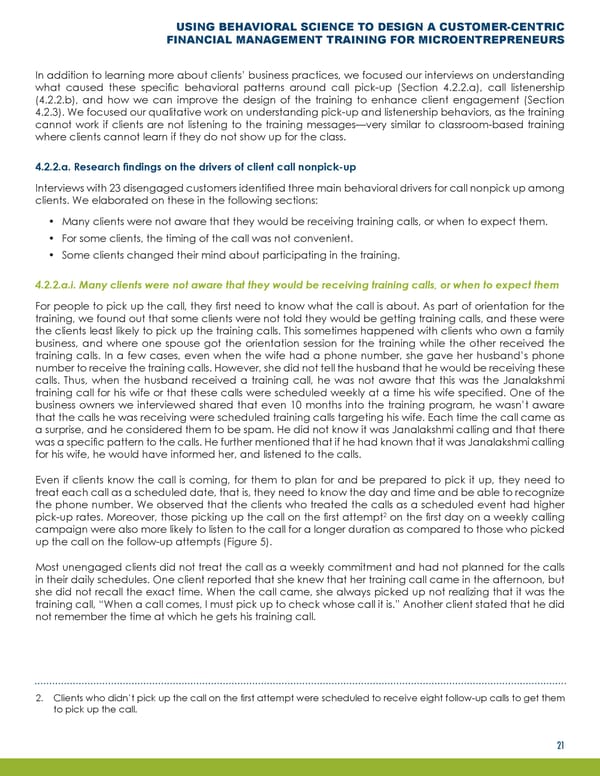USING BEHAVIORAL SCIENCE TO DESIGN A CUSTOMER-CENTRIC FINANCIAL MANAGEMENT TRAINING FOR MICROENTREPRENEURS In addition to learning more about clients’ business practices, we focused our interviews on understanding what caused these specific behavioral patterns around call pick-up (Section 4.2.2.a), call listenership (4.2.2.b), and how we can improve the design of the training to enhance client engagement (Section 4.2.3). We focused our qualitative work on understanding pick-up and listenership behaviors, as the training cannot work if clients are not listening to the training messages—very similar to classroom-based training where clients cannot learn if they do not show up for the class. 4.2.2.a. Research findings on the drivers of client call nonpick-up Interviews with 23 disengaged customers identified three main behavioral drivers for call nonpick up among clients. We elaborated on these in the following sections: • Many clients were not aware that they would be receiving training calls, or when to expect them. • For some clients, the timing of the call was not convenient. • Some clients changed their mind about participating in the training. 4.2.2.a.i. Many clients were not aware that they would be receiving training calls, or when to expect them For people to pick up the call, they first need to know what the call is about. As part of orientation for the training, we found out that some clients were not told they would be getting training calls, and these were the clients least likely to pick up the training calls. This sometimes happened with clients who own a family business, and where one spouse got the orientation session for the training while the other received the training calls. In a few cases, even when the wife had a phone number, she gave her husband’s phone number to receive the training calls. However, she did not tell the husband that he would be receiving these calls. Thus, when the husband received a training call, he was not aware that this was the Janalakshmi training call for his wife or that these calls were scheduled weekly at a time his wife specified. One of the business owners we interviewed shared that even 10 months into the training program, he wasn’t aware that the calls he was receiving were scheduled training calls targeting his wife. Each time the call came as a surprise, and he considered them to be spam. He did not know it was Janalakshmi calling and that there was a specific pattern to the calls. He further mentioned that if he had known that it was Janalakshmi calling for his wife, he would have informed her, and listened to the calls. Even if clients know the call is coming, for them to plan for and be prepared to pick it up, they need to treat each call as a scheduled date, that is, they need to know the day and time and be able to recognize the phone number. We observed that the clients who treated the calls as a scheduled event had higher 2 on the first day on a weekly calling pick-up rates. Moreover, those picking up the call on the first attempt campaign were also more likely to listen to the call for a longer duration as compared to those who picked up the call on the follow-up attempts (Figure 5). Most unengaged clients did not treat the call as a weekly commitment and had not planned for the calls in their daily schedules. One client reported that she knew that her training call came in the afternoon, but she did not recall the exact time. When the call came, she always picked up not realizing that it was the up to check whose call it is.” Another client stated that he did training call, “When a call comes, I must pick not remember the time at which he gets his training call. 2. Clients who didn’t pick up the call on the first attempt were scheduled to receive eight follow-up calls to get them to pick up the call. 21
 Using Behavioral Science to Design a Customer-Centric Financial Management Training for Microentrepreneurs Page 23 Page 25
Using Behavioral Science to Design a Customer-Centric Financial Management Training for Microentrepreneurs Page 23 Page 25